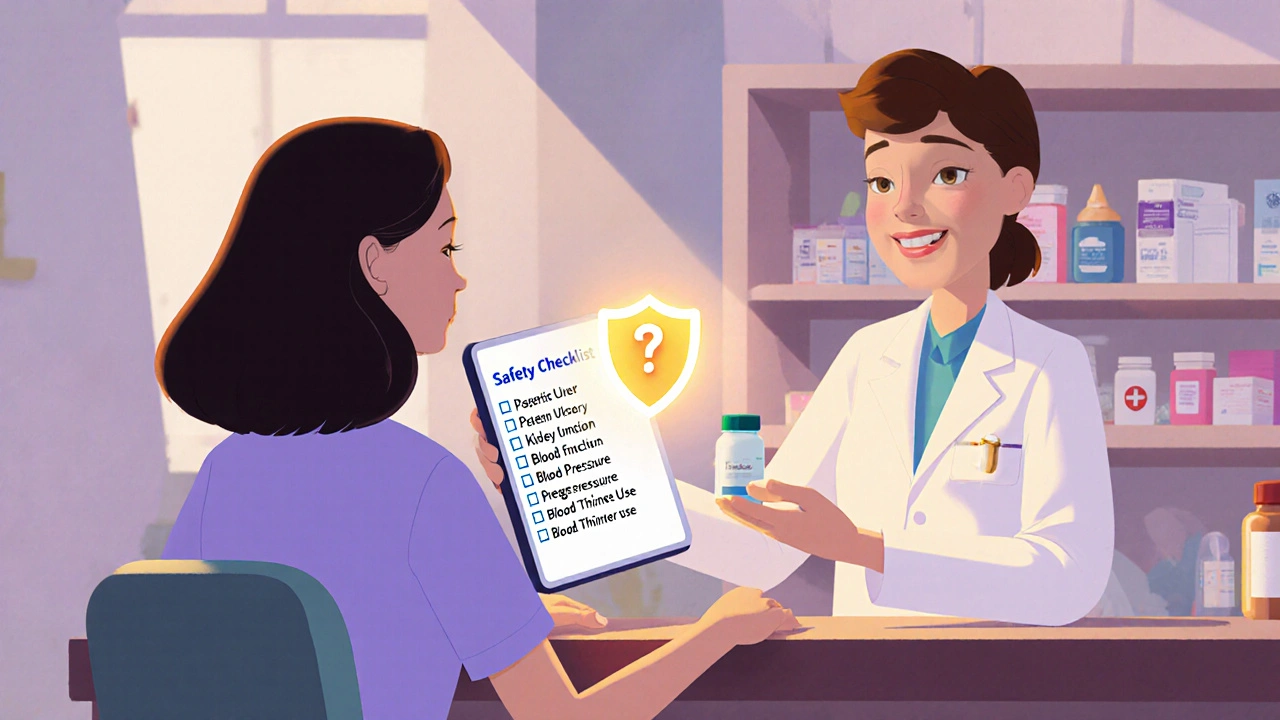When a doctor prescribes a strong anti‑inflammatory pill, many patients wonder how Indocin (indomethacin) works, what its downsides are, and whether there’s a gentler option.
What is Indocin (Indomethacin)?
Indocin is a prescription‑only non‑steroidal anti‑inflammatory drug (NSAID) that belongs to the acetic acid class. First approved in the United States in 1963, it’s been used for arthritis, gout flares, and certain types of acute pain.
How does Indocin work?
Indocin blocks both cyclooxygenase‑1 (COX‑1) and cyclooxygenase‑2 (COX‑2) enzymes, lowering the production of prostaglandins that cause inflammation, fever, and pain. Because it hits both COX isoforms, it’s powerful but also carries a higher risk of stomach irritation and kidney effects compared with COX‑2‑selective drugs.
Common alternatives to Indocin
If you need pain relief but are nervous about Indocin’s side‑effects, several other NSAIDs are worth a look. Below are the most frequently mentioned substitutes, each with its own balance of effectiveness and safety.
- Ibuprofen (Advil, Motrin) - a propionic‑acid NSAID with moderate COX‑1/COX‑2 inhibition, popular for mild‑to‑moderate pain.
- Naproxen A longer‑acting propionic‑acid NSAID often chosen for chronic conditions like osteoarthritis.
- Celecoxib A COX‑2‑selective NSAID marketed as Celebrex, designed to spare the stomach but still control inflammation.
- Meloxicam A slightly COX‑2‑preferential drug used for rheumatoid arthritis and osteoarthritis.
- Aspirin One of the oldest NSAIDs, low‑dose aspirin is mainly for cardiovascular protection, but higher doses provide anti‑inflammatory effects.
- Diclofenac A phenylacetic acid NSAID frequently prescribed for joint pain and sports injuries.
Head‑to‑head comparison
| Drug | Typical dosage form | Usual adult dose | COX selectivity | Common side‑effects | Best for |
|---|---|---|---|---|---|
| Indocin | Oral tablet, injectable | 25‑150mg/day split | Non‑selective (COX‑1 & COX‑2) | Stomach upset, renal strain, headache | Severe gout flares, ankylosing spondylitis |
| Ibuprofen | Oral tablet, liquid | 200‑800mg every 6‑8h | Non‑selective, mild COX‑1 | GI irritation, mild hypertension | Everyday aches, menstrual cramps |
| Naproxen | Oral tablet, liquid | 250‑500mg twice daily | Non‑selective, longer half‑life | GI irritation, increased cardiovascular risk | Chronic joint pain, back pain |
| Celecoxib | Oral capsule | 100‑200mg once or twice daily | COX‑2 selective | Less stomach upset, but possible heart risk | Patients needing GI‑friendly NSAIDs |
| Meloxicam | Oral tablet, injection | 7.5‑15mg once daily | COX‑2 preferential | GI symptoms, rare skin reactions | Long‑term arthritis management |
| Aspirin | Oral tablet | 300‑1000mg every 4‑6h (anti‑inflammatory) | COX‑1 predominant | Bleeding, stomach ulcers | Low‑dose cardio protection; high‑dose inflammation |
When might Indocin be the right choice?
Indocin shines when you need rapid, potent relief for conditions that other NSAIDs struggle with. Its efficacy in gout attacks is especially notable - a single 50mg dose can bring a painful flare under control within hours. If you have ankylosing spondylitis or severe acute bursitis, the stronger COX inhibition often outweighs the GI risk, provided you have a healthy stomach or are using a protective proton‑pump inhibitor.
However, the drug’s drawbacks mean it isn’t first‑line for everyday aches. Patients with a history of ulcers, chronic kidney disease, or heart failure should discuss alternatives first.
Safety and side‑effect considerations
All NSAIDs share a core risk profile: stomach irritation, increased bleeding, and potential kidney strain. Indocin adds a higher chance of central nervous system side‑effects like dizziness or headache. Here’s a quick safety checklist you can run through with your pharmacist:
- Do you have a history of peptic ulcer disease? If yes, ask about adding a proton‑pump inhibitor.
- Are you on blood‑thinners (warfarin, DOACs) or antiplatelet drugs? NSAIDs can amplify bleeding.
- Do you have hypertension or heart disease? Some NSAIDs raise blood pressure; monitor regularly.
- Is your kidney function normal? Older adults are especially vulnerable.
- Are you pregnant? Indomethacin is contraindicated in the third trimester.
For many patients, swapping to a COX‑2‑selective option like celecoxib reduces stomach risk while still delivering good pain control. But remember, selective drugs may carry a modestly higher cardiovascular warning, so they’re not universally safer.

Practical tips for talking to your doctor or pharmacist
- Bring a list of every medication you take, including over‑the‑counter supplements.
- Ask specifically about the duration of Indocin therapy - short bursts are usually safer than long‑term use.
- If you need an alternative, request a side‑by‑side comparison of ibuprofen, naproxen, and celecoxib based on your health profile.
- Clarify whether a gastro‑protective agent (e.g., omeprazole) should be paired with the NSAID.
- Never double‑dose or combine multiple NSAIDs without professional guidance.
Open communication helps you avoid unnecessary side‑effects while still getting the pain relief you need.
Frequently Asked Questions
Frequently Asked Questions
Can I take Indocin with ibuprofen?
No. Combining two NSAIDs increases the risk of stomach bleeding and kidney problems without adding pain relief. If you’ve already taken a dose of ibuprofen, wait at least 6‑8hours before starting Indocin, and only do so under a doctor’s order.
Is Indocin safe for older adults?
Older adults are more prone to the GI and renal side‑effects of all NSAIDs. If an older patient needs Indocin, doctors usually prescribe the lowest effective dose for the shortest possible time and add a stomach protector.
What makes celecoxib different from Indocin?
Celecoxib selectively blocks COX‑2, sparing COX‑1, which protects the stomach lining. Indocin blocks both enzymes, giving stronger pain relief but higher ulcer risk. The trade‑off is between potency and GI safety.
How quickly does Indocin start working?
Because it’s a potent NSAID, pain relief can begin within 30‑60minutes, and the anti‑inflammatory effect peaks around 2‑4hours after the first dose.
Can I use Indocin for chronic back pain?
It’s possible but not ideal. Chronic use raises the chance of ulcers, high blood pressure, and kidney issues. Doctors often switch patients to a COX‑2‑selective drug or a lower‑dose NSAID for long‑term management.


Raina Purnama
October 16, 2025 AT 12:43Indocin is a potent NSAID that hits both COX‑1 and COX‑2, making it effective for acute gout flares but also raising GI risk. For patients who can tolerate it, short‑term use with a proton‑pump inhibitor is a reasonable strategy, while many find ibuprofen or naproxen sufficient for everyday aches.
April Yslava
October 20, 2025 AT 09:43They don’t want you to know there are safer pills out there because the big pharma lobby funds the research that keeps Indocin in the spotlight. You’ll see the same “expert” panels pushing this drug while the real alternatives get buried under red‑tape. It’s a classic case of the government and corporations colluding to keep us dependent on expensive, risky medication. If you read between the lines you’ll notice the recurring hype around “potency” is just a marketing ploy. Don’t be fooled by the glossy brochures; ask for a generic NSAID like naproxen instead and you’ll save both your wallet and your gut.
Rebecca Bissett
October 24, 2025 AT 06:43Wow!!! This article really hits home!!! Indocin can feel like a double‑edged sword-powerful relief on one side, a gnawing stomach pain on the other!!! It’s heartbreaking to see patients suffer because they don’t get the right guidance!!! Remember, you’re not alone when you’re wrestling with side‑effects!!! Talk to your pharmacist, get that PPI, and breathe!
josh Furley
October 28, 2025 AT 02:43Honestly, the hype around Indocin being “dangerous” is overblown 😅. Sure it blocks COX‑1 and COX‑2, but that’s exactly why it knocks out inflammation fast. If you’re afraid of ulcers, just pair it with a PPI and you’re good. The “safer” drugs like ibuprofen are slower and sometimes won’t cut it for a gout attack. Bottom line: for a genuine flare, Indocin still has its place, especially when time is of the essence.
Carissa Engle
October 31, 2025 AT 23:43Indocin works by inhibiting both COX‑1 and COX‑2 enzymes. This dual inhibition provides strong anti‑inflammatory effects. Because it is non‑selective it can cause more gastrointestinal irritation. Patients with a history of ulcers should be cautious. The drug is often prescribed for severe gout attacks. It can bring pain relief within an hour. The rapid onset is useful in acute settings. However the risk of renal strain cannot be ignored. Older adults are particularly vulnerable to kidney issues. Combining Indocin with other NSAIDs increases the danger. A proton‑pump inhibitor can mitigate stomach problems. Dosage should be the lowest effective amount. Short courses are generally safer than long term use. Monitoring blood pressure is advisable during therapy. Discuss any other medications with your doctor before starting Indocin.
Dervla Rooney
November 4, 2025 AT 20:43Thank you for laying out the key points so clearly. Your checklist is especially helpful for patients who are new to Indocin. It’s important to emphasize the role of gastro‑protective agents when the drug is needed. I would also add that regular lab work can catch any renal changes early. Overall, a balanced approach with close monitoring makes the benefits outweigh the risks for many.
Johnny Ha
November 8, 2025 AT 17:43Yo, but don’t forget the pharmacy guys sometimes push the cheap stuff to keep margins high. They’ll tell you a PPI is “optional” even when you’ve got a history of ulcers. Keep an eye on the fine print and call them out if they try to downplay the side‑effects. It’s all part of the same game.
Mary Cautionary
November 12, 2025 AT 14:43In the contemporary pharmaco‑therapeutic landscape, Indomethacin occupies a niche characterized by its robust cyclooxygenase inhibition. While its efficacy in mitigating acute inflammatory cascades is incontrovertible, the attendant gastro‑renal sequelae necessitate judicious prescription. Accordingly, clinicians must calibrate dosage regimens with meticulous attention to comorbid pathology.
Crystal Newgen
November 16, 2025 AT 11:43Just a heads up that if you’re rotating between NSAIDs, give your stomach a break every now and then. A day off can make a big difference.
Hannah Dawson
November 20, 2025 AT 08:43While your suggestion is well‑meaning, it glosses over the pharmacokinetic interactions that can arise from alternating ibuprofen and naproxen. The half‑life differences mean residual plasma levels may compound, increasing bleeding risk. A more rigorous schedule should be employed, ideally under medical supervision, to avoid inadvertent overexposure.
Victoria Unikel
November 24, 2025 AT 05:43I dont trust that indocin stuff.
Rama Hoetzlein
November 28, 2025 AT 02:43Come on, that’s just fear‑mongering 🙄. If you actually read the data you’ll see Indocin is only dangerous when misused. Stop the drama and talk to a professional.
Annie Tian
December 1, 2025 AT 23:43Let’s keep the conversation constructive! It’s great that you want to learn more! Remember, the best outcomes happen when patients and doctors collaborate! 😊
April Knof
December 5, 2025 AT 20:43In many cultures, sharing information about medication risks is considered a communal responsibility. Providing clear guidance helps everyone stay safe and healthy.
Ellie Hartman
December 9, 2025 AT 17:43Exactly, and it’s also a good practice to write down any side‑effects you notice. That way you can give your doctor a precise report and adjust the treatment plan together.
Jason Divinity
December 13, 2025 AT 14:43The lexicon of non‑steroidal anti‑inflammatory agents is as varied as the hues of a sunrise, yet Indomethacin remains a formidable titan among them. Its dual COX antagonism bestows swift analgesia, but the specter of gastrointestinal turmoil looms large. Hence, the judicious clinician must wield it like a finely honed blade-effective yet measured.